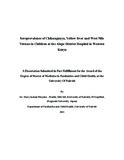| dc.description.abstract | Background: Arboviruses including Chikungunya virus, Yellow fever virus and West Nile virus are recognized causes of acute febrile illness in the tropics, and have been responsible for epidemic outbreaks in some parts of Kenya. During the past 20 years there has been a dramatic epidemic resurgence of a number of well-known arbovirus diseases thought to be effectively controlled or unimportant Other viruses have expanded their geographic, distribution such as the spread of Rift Valley fever virus in East Africa. However, these arbovirus diseases are not usually regarded as a differential diagnosis in children with fever in Kenyan health institutions because of lack of readily available and affordable diagnostic tests to detect them and a low index of suspicion.
The majority of arbovirus infections remain undiagnosed; as a result the frequency of arbovirus disease and the public health threat they pose is greatly underestimated. The non-specific nature of the clinical signs and symptoms of arbovirus infections makes it difficult to differentiate them from illnesses such as malaria, typhoid, dysentery and bacterial meningitis. Despite this, few surveys have been done to document the magnitude of infections from these viruses in children in Kenya. Primary objective: To determine the seroprevalence of Chikungunya virus, Yellow fever virus and West Nile virus exposure in children attending Alupe District Hospital and KEMRI Alupe clinic.
Secondary objectives: To describe socio-demographic and clinical features observed in the exposed children, and the factors associated with seropositivity. Study design: Hospital based cross sectional study. Study sites: Alupe District Hospital and KEMRI Alupe Clinic.
Methodology: Children aged between one and twelve years whose parents/guardians gave informed consent were recruited consecutively into the study. Clinical and sociodemographic data was collected using a questionnaire and blood drawn for analysis.
Standard tests for malaria and typhoid were done for all children with reported or confirmed fever. A routine human immunodeficiency virus (HIV) test was also done for those who opted for it. Indirect Enzyme Linked Immunosorbent Assays were done to screen for the presence of antibodies to the selected arboviruses. Data analysis was performed usingiSTATA for Mac Version 9.
Results: Between August and December 2010, 425 eligible children were recruited into the study. 209 were males and 216 females. The Seroprevalence of arboviruses were as follows: Overall] 136(32%) were positive fot at least one arbovirus exposure. Thirty one percent of 296 tested were positive for WNVj eleven percent of 298 tested were positive for CHIK.V and seventeen percent of the 310 tested for YFV were positive. Having bushes, trees or forests near the home, photophobia, bruising of skin and dehydration and a positive malaria test were significantly associated with arbovirus seropositivity (p<0.05). Use of other mosquito control measures besides mosquito nets was associated with significant protection from West Nile virus and any arbovirus seropositivity
Conclusion: Children in Teso District are exposed to WNV, CHIKV, YFV and possibly other Arboviruses. Further studies are required to determine the prevalence and distribution of arboviruses in the wider Teso Community. Furthermore, virus isolation studies and virus characterization are required to determine specific strains circulating in the area and the role of arboviruses in the causation of fever in children. Personal protection from and vector control strategies are needed to control and prevent the transmission of. arboviruses to non-immune populations like children. The use of other mosquito control measures besides mosquito nets confers significant protection from any arbovirus and WNV seropositivity but not from CHIKV or YFV seropositivity. | en_US |

